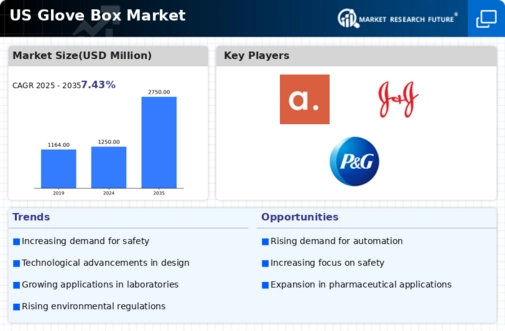Emergence of Advanced Materials
The glove box market is also being shaped by the emergence of advanced materials that require specialized handling. Industries such as electronics and nanotechnology are increasingly utilizing materials that are sensitive to environmental factors. Glove boxes provide the necessary isolation to prevent contamination and degradation of these materials. As the US electronics market is projected to grow to $1 trillion by 2025, the demand for glove boxes tailored for advanced material handling is likely to increase. This trend indicates a shift towards more sophisticated glove box designs that cater to the unique requirements of these emerging materials.
Increased Focus on Laboratory Safety
Safety regulations in laboratories are becoming increasingly stringent, thereby propelling the glove box market forward. Laboratories are mandated to provide safe working environments for their personnel, particularly when handling hazardous materials. Glove boxes serve as critical barriers, protecting users from exposure to toxic substances and ensuring that experiments are conducted in a controlled atmosphere. The US Occupational Safety and Health Administration (OSHA) has implemented guidelines that necessitate the use of such equipment in various sectors, including chemical and biological research. This regulatory landscape is likely to enhance the demand for glove boxes, as organizations prioritize safety and compliance.
Rising Demand in Pharmaceutical Sector
The glove box market is experiencing a notable surge in demand, particularly from the pharmaceutical sector. This growth is driven by the increasing need for controlled environments to handle sensitive materials and compounds. As pharmaceutical companies focus on research and development, the requirement for glove boxes to ensure contamination-free processes becomes paramount. In 2025, the pharmaceutical industry in the US is projected to reach approximately $600 billion, with a significant portion allocated to laboratory equipment, including glove boxes. This trend indicates a robust market for glove boxes, as they are essential for maintaining the integrity of pharmaceutical products and ensuring compliance with stringent regulatory standards.
Growth in Research and Development Activities
The glove box market is significantly influenced by the expansion of research and development (R&D) activities across various sectors. With increased funding for scientific research, particularly in biotechnology and materials science, the need for specialized equipment like glove boxes is on the rise. In 2025, R&D spending in the US is expected to exceed $600 billion, with a considerable share directed towards laboratory infrastructure. This trend suggests that as R&D activities intensify, the glove box market will likely benefit from heightened demand, as researchers require reliable solutions for maintaining sterile and controlled environments.
Integration of Automation in Laboratory Processes
The glove box market is witnessing a transformation due to the integration of automation in laboratory processes. Automated glove boxes are becoming more prevalent, allowing for enhanced efficiency and precision in handling sensitive materials. This trend is particularly relevant in high-throughput laboratories where time and accuracy are critical. As automation technology continues to advance, the glove box market is expected to adapt, offering solutions that incorporate robotic systems and smart technologies. This evolution may lead to increased adoption of glove boxes, as laboratories seek to optimize their workflows and improve overall productivity.














Leave a Comment